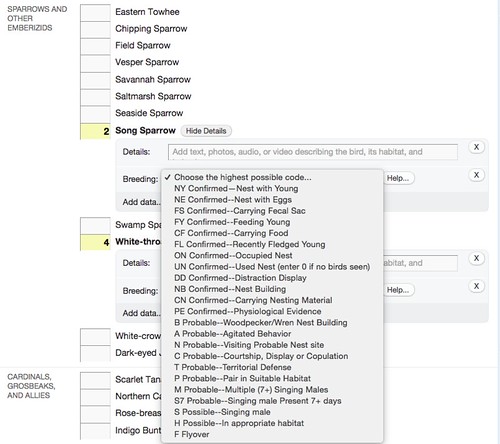Early April, really, is the beginning of spring migration. Warblers have not yet begun to invade most of the United States, but there are a few early migrants: phoebes, Chipping Sparrows, and perhaps two or three species of warblers.
Around where I am, the place to go at this time of year is Hempstead Lake State Park. It boasts woods (good for migrants) as well as large bodies of water (good for lingering waterfowl). It also happens to be right on the way to the violin shop where I get my violin checked over in the early spring, so what harm could it do to stop and take a look around?
The first bird of interest was an
Osprey over the lake, seen from the car as we pulled into the parking lot. I was soon distracted from the Osprey by something that was not, in fact, a bird at all: a
Mourning Cloak butterfly, the first butterfly to emerge here in New York, often coming out as early as late February. This one seemed quite tame and allowed me to approach to the point where my camera could no longer focus. Two male
Downy Woodpeckers fought in the trees.
 |
| Mourning Cloak |
Down in the woods by the South Pond, a pair of Tufted Titmice bounced around and looked cute in the brush while Common Grackles and Red-winged Blackbirds bathed in a stream. Here at the beginning of spring, I could really see the advantage it is to have studied your bird songs: by ear alone, I picked out a Belted Kingfisher, White-throated Sparrow, Song Sparrow, Northern Cardinal and Red-bellied Woodpecker. Another Osprey flew directly overhead, and a Great Blue Heron made an awkward landing by the edge of the pond.
Looking closer at the surface of the water, I could see dozens of acrobatic Tree Swallows, my first-of-season, skimming over the pond, hunting bugs. In their midst, a larger creature emerged--a Beaver swimming towards the shore. Some Red-eared Sliders (turtles) basked on a log.
 |
Tree Swallows. Terrible picture, I know, but you try catching a bird
moving that fast on camera. |
 |
| Hello, Mr. Beaver! |
At this point, I was happy with the birds and other animals we were getting, but I was missing three sought-after and celebrated migrants--Eastern Phoebe, Palm Warbler and Pine Warbler. Although the phoebe never showed, the other two were testaments to the importance of birding by ear.
As we were walking back towards the car, I heard an unmistakable trill. I confirmed it with a recording pulled up on my dad's phone--it was, indeed, a Pine Warbler. Having heard it, I could count it for a list, an eBird checklist, whatever, but I wanted to see it too. After hearing the song several more times, I saw an unmistakable Pine Warbler flitting to and fro next to a Chipping Sparrow in some brush. It flew back into the woods with a friend. Chasing it, I came upon another, and another, and then another. Just as I thought I was seeing six Pine Warblers, I gave a closer inspection to one of them and realized that it was in fact a Palm Warbler, one of several that were ducking in and out of the brush.
 |
| Pine Warbler |
Moments later, I turned to see my mother gesturing at me, pointing at something in a pile of fallen logs. I
pished, and the bird popped into view for a moment, but only in silhouette. It was a wren, some sort of very tiny wren.
In a second, the bird popped up onto a log and showed itself. It was a Winter Wren! It was just a tad late, Winter Wrens only truly become uncommon on Long Island in May. I had come in search of spring migrants but was also reminded that winter was only just past.
It was 3:15. I had been birding over an hour, and an hour was as long as you were allowed to stay in the parking lot (if you had paid when I did). Thus, I headed back to the car, got in, and left the warblers behind there at Hempstead Lake.
Left the warblers behind--for now.
 |
| Osprey |
 |
| Pine Warbler |






